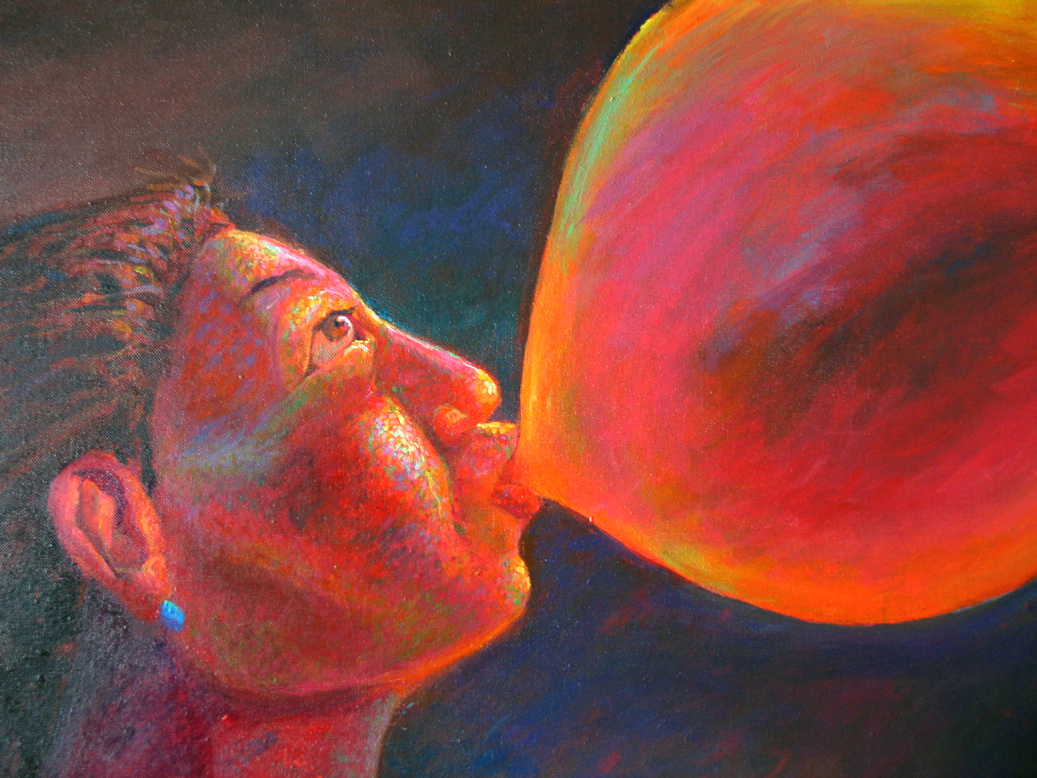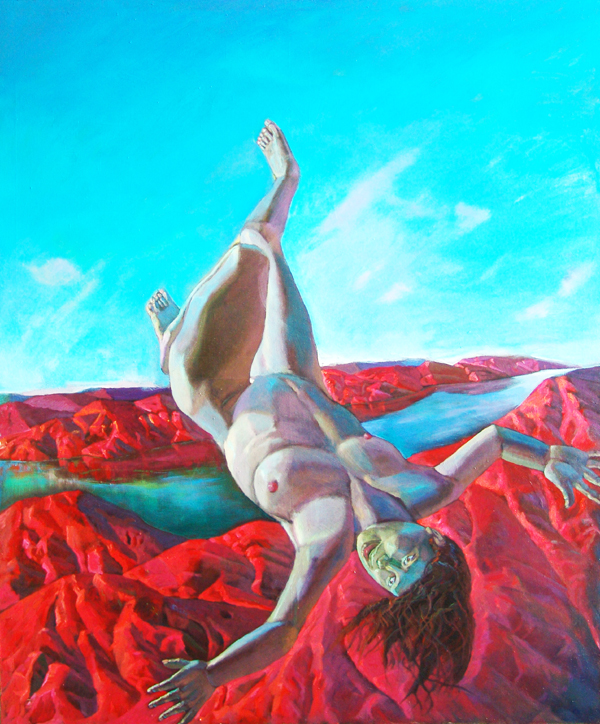Writings, comments and images shown on the works of artists working inside Tibet are presented on this website without the artists' consent and solicitation. The writers, scholars, foreign art collectors, translators and photographers who contribute articles such as this are solely responsible for the content and opinions expressed.
On recent paintings of Tsering Nyandak
Tsering Woeser (08.16. 2006) translated by Susan Chen
Nyendak is a Lhasawa. From a distance, I saw him walking closer. His youthfulness and disability hit a  tender spot in my heart.
tender spot in my heart.
It used to be very easy to recognize that those who appear in Nyendak's paintings are Tibetans. Lately, it is no longer the case. You can feel that he has done so intentionally-intentionally not letting his viewers be able to quickly decide on the identity of his sitters. Instead, he has been focusing on the theme of falling women.* He paints them slowly falling from the sky, smiling, looking relaxed and comfortable-including the one who is at the same time blowing up a balloon. (Too bright the balloon looks!) Disappearing from his canvases are those immediately recognizable symbols of Tibet: Tibetan dress, Tibetan hairstyles, Tibetan ornaments, and even the custom among common Tibetans of sticking their tongues out to greet each other. (Nyendak would like to make sure that you notice he is poking fun at the custom.) Yet, Nyendak recently seems to have decided to erase these Tibetan signs. He doesn't need them since he himself is in Tibet and so Tibetan. Nevertheless, there is still something in this new batch of the artist's work that speaks to my heart; they remind me of the way I used to feel about my own soul broken into pieces, drifting, and flying-.
It is interesting to observe that, although Nyendak now seemingly prefers to keep the identity of his paintings outwardly ambiguous, in my eyes, they still make him the artist voicing what is going on in contemporary Tibet. With or without putting Tibetan garb for the figures in his painting, they always unmistakably resemble the real people from Amdo, U-Tsang, or Kham. They kept me lingering around in front of his paintings. Also, I should add that what Nyendak conveys is, I think, more than just a likeness on the surface. Having myself as an example, my upbringing, my way of dressing myself, the way I speak Chinese-.they all help me be often mistaken as a Chinese. Yet, am I? Am I a Chinese? Yes, you are right; I am of course not. I am just like you; we are Tibetans hiding our sole identity deep inside our hearts. To say so does not mean I am nationalistic; I only want to be reassured of my own identity. That's all.
Nyendak hangs his paintings at a street corner along Bakhor and quietly settles himself in one of the courtyards in Tsemoenling-.. As for me, I was so eager to see his paintings, perhaps only because I found myself sharing the confusion of those who appear in his paintings. Even just at this moment when I am writing, I find something new: Yes, I see in his figures something about absence, about failure, which is mine and ours. Of course, Nyendak knows how to give light touches to his work and likes to "unintentionally" capture the details of everyday lives. For instance, he reveals that under the chuba of the Khamba woman riding on the bike are her red sport pants and a pair of tennis shoes! I admit that I am very enchanted by these kinds of details, although they seem to only appear in the earlier works of the artist. Now, what remains is only a hint of the Tibetan landscape that he paints from the perspective of the women who are falling from the sky slowly and look carefree. What can be better compared with the views that they are seeing? It is perhaps just like what you can see by pressing your nose to the small windows on an airplane steadily passing through the sky above the Amdo-Tibet plateau; you look down, find the endless mountain ranges, and glimpse tiny Tibetan houses that are scattered over or tucked away from the landscape.
What can be better compared with the views that they are seeing? It is perhaps just like what you can see by pressing your nose to the small windows on an airplane steadily passing through the sky above the Amdo-Tibet plateau; you look down, find the endless mountain ranges, and glimpse tiny Tibetan houses that are scattered over or tucked away from the landscape.
When others cannot live without appropriating Tibetan symbols or Tibetanizing the scenes and human figures they create-as a Han artist who resided in Tibet for many years has recently done through his performance art of smearing the internet sign "@" all over mani stones and prayer flags-Naydrak, the painter, is deleting and subtracting, as though he is at home, in the midst of family members, feeling no need for any artificial gesture or heavy make-up.
*Translator's note: "Falling" here is to be taken both literally and in a moral sense.
